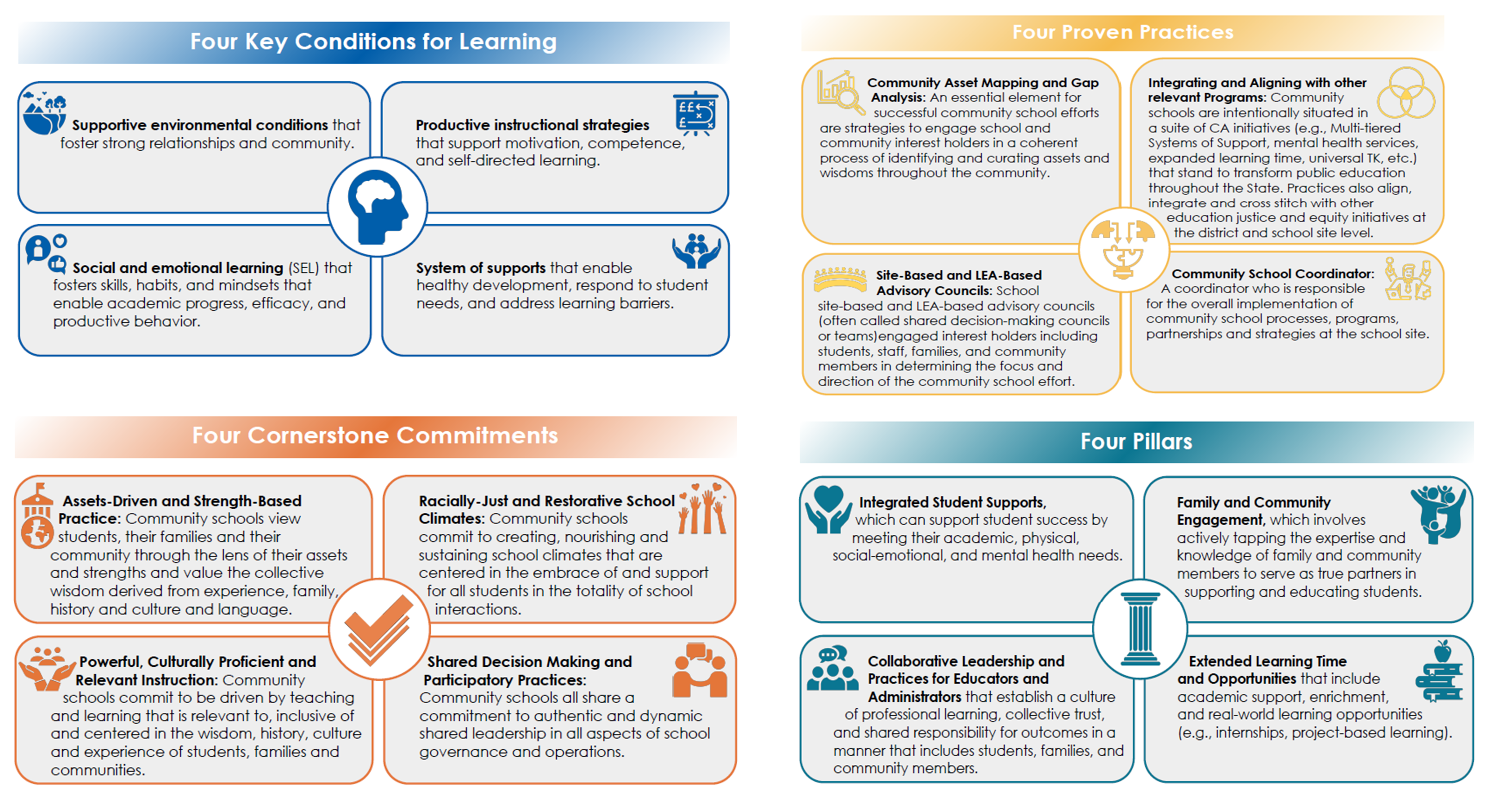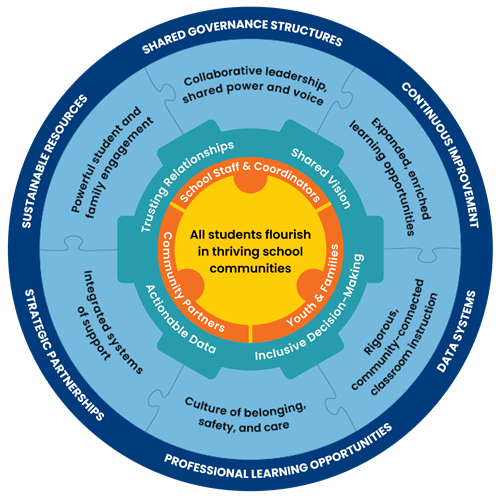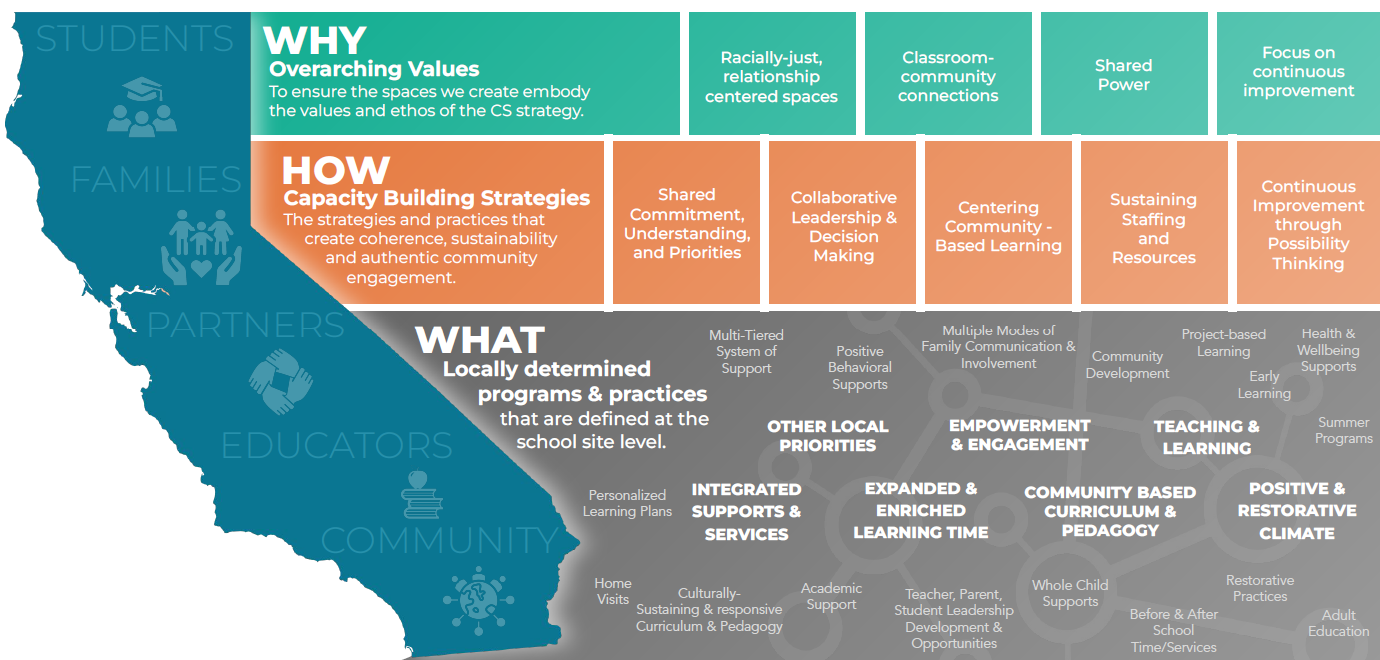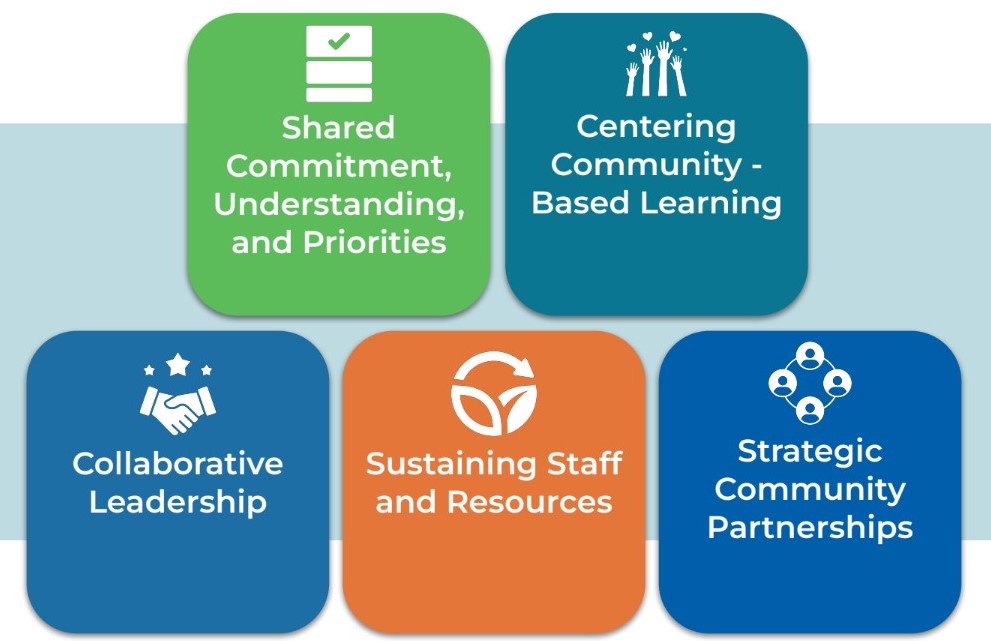Community Schools
Page Navigation
- Community Schools Strategic Initiative: Overview
- Community Schools Strategic Initiative: Directory
- Community Schools Strategic Initiative: Partners
- Community Schools Strategic Initiative: Calendar of Events
- Community Schools Strategic Initiative: In Action
- Community Schools Strategic Initiative: Making Headlines
- Community School Support & Coordination Council (CSSCC)

-
Santa Ana Unified School District
Community Schools Strategic Initiative
Vision and Core Values
Vision: To collaboratively transform our schools into inclusive, supportive environments where every child’s holistic development is prioritized, ensuring they grow from prenatal stages to becoming empowered, community-oriented global citizens.
Mission: Engage our entire community in the educational process to empower all stakeholders as shared decision-makers and problem-solvers, fostering equity and holistic development for all students. Together, we will continuously improve and learn, addressing challenges and creating solutions hand-in-hand.
Core Values:
- Engagement: Involving 100% of our community in the educational process.
- Empowerment: Empowering students, parents, and community members to be shared decision-makers and problem-solvers.
- Equity: Ensuring equitable outcomes for all students and community members.
- Holistic Development: Prioritizing the physical, cognitive, language, social, ethical, and psychological development of every child.
Explanation of Our Logo
Our logo symbolizes our commitment to the community and the holistic development of every child.
- The Tree: Represents growth, nurturing, and the interconnectedness of our community.
- The Hands: Signify the entire support system, uplifting and supporting our community. Just as a hand is made up of different components, each equally important, our community is sustained by the collective effort of various stakeholders.
- The Heart: Symbolizes passion for the work, love for our community, and the personal nature of this mission.
- The Figures Under the Tree: Represent the development of a child from baby to actualized global citizen, showcasing the holistic growth from prenatal stages to adulthood.
- The Colors:
- Blue: Trust and stability.
- Green: Growth and development.
- Orange: Creativity and enthusiasm.
Overview
The Santa Ana Unified School District (SAUSD) has 15 community schools, including 13 elementary schools, one middle school, and one high school. These schools are committed to implementing the community schools strategy aimed at creating equitable, racially just, and culturally responsive educational environments. They embody the district's commitment to providing holistic and inclusive education, ensuring that every student has the support and resources needed to thrive academically, socially, and emotionally. Through the community schools framework, SAUSD continues to foster strong partnerships and collaborative efforts that benefit students, families, and the broader community.
Our Community Schools serve students from pre-Kindergarten through high school with a holistic approach, prioritizing the physical, cognitive, language, social, ethical, and psychological development of every child. This strategy integrates academics, health and social services, youth and community development, and community engagement. The California Community Schools (CA CS) Framework, adopted in 2022, is central to this approach.
-

Community schools are a research-based, comprehensive school transformation strategy where educators, local community members, families, and students collaborate to enhance conditions for student learning and healthy development. Together, they organize both in-school and out-of-school resources, supports, and opportunities, enabling young people to thrive.
Community schools have a long history, existing for over a century. Today, modern community schools focus on whole-child practices and structures that support the holistic development of children. Recognizing that children spend about 80% of their time in their communities during any given school year, it’s clear that to truly transform our schools and communities, we must work together. This collective effort ensures that both educational environments and community contexts are aligned to foster student learning and healthy development.
To support this transformative work, the State of California is providing funding and support through the California Community Schools Partnership Program (CCSPP). The state has identified four core values that guide our work. These values are foundational to our strategy and represent the "why" behind our efforts. The core values are:
- Racially-Just, Relationship-Centered Spaces: Community schools aim to build trust by bringing people together and authentically valuing diverse cultures, perspectives, and strengths. A focus on relationships builds a positive school climate and culture that is racially-just, caring, and nurturing a sense of belonging.
- Shared Power: Community schools are grounded in the belief that schools belong to all of us—students, families, school staff, and the community. Recognizing and building towards shared ownership and deep engagement through shared decision-making and collaborative strategies is vital to building a democratic, inclusive, and empowering environment.
- Classroom-Community Connections: Community schools continuously link classroom instruction to the broader community, providing real-world and project-based learning opportunities. The curriculum is responsive to local history, knowledge, values, language, literature, institutions, culture, and environments.
- Continuous Improvement: Community schools engage in an ongoing cycle of reflection, analysis, shared learning, and revision with a focus on student learning conditions and outcomes. This approach ensures that students, families, school staff, and the community are valued, engaged, and empowered.
Click here to learn more about the Overarching Values
The "how" of our work is guided by the Capacity-Building Strategies developed by the State Transformational Assistance Center (S-TAC). These strategies are designed to ensure that Local Educational Agencies (LEAs) and school sites focus on research-based practices as they transform into community schools. The Capacity-Building Strategies focus on five key areas:
- Shared Commitment, Understanding, and Priorities: Uniting stakeholders through a shared understanding and commitment to the community school strategy.
- Centering Community-Based Learning: Building on the cultural and linguistic assets of students, families, and educators to create engaging and relevant learning experiences.
- Collaborative Leadership: Ensuring all stakeholders have a voice in decision-making, fostering supportive relationships, and improving coordination and alignment.
- Sustaining Staff and Resources: Ensuring the necessary human and financial resources are available to maintain the community school vision and strategy over time.
- Strategic Community Partnerships: Developing partnerships to expand capacity and support a broad range of priorities, from expanded learning to integrated student and family supports.
Click here to learn more about the Capacity Building Strategies
Additionally, the California Community Schools Framework provides a comprehensive structure for our implementation.
It includes:

To ensure a more complete and robust implementation, we are also adhering to the Community Schools Forward Essentials for Community School Transformation. This framework was developed in consultation with over 700 practitioners, non-profit leaders, teachers, coordinators, researchers, and policymakers. Importantly, it synthesizes long-standing experience from practitioners; existing models of community schools; and recent research on the science of learning and development. The result is an evolved framework that includes six key integrated practices.

Four of the six key practices grew directly out of the four pillars for community schools. Based on the voices and experiences of hundreds of practitioners and the latest research on how children learn best, the Community Schools Forward team also added two new practices:
- Integrated Systems of Support: School staff and community partners should systematically coordinate health and social services, academic and nonacademic supports, and enrichment opportunities in a manner that fosters student wellbeing.
- Expanded and Enriched Learning Opportunities: Students need access to before- and after-school and summer opportunities in which they can explore their passions, apply academic content beyond the classroom, and build knowledge.
- Powerful Student and Family Engagement: Families and students must be active participants in the school community and serve as key partners in decision-making and shaping the school’s environment and priorities.
- Collaborative Leadership and Shared Power and Voice: Families, students, teachers, principals, and community partners should make decisions together through formal and informal structures.
- Rigorous, Community-Connected Classroom Instruction: The curriculum should connect high-level content and skills to students’ identities, cultures, and experiences, and students should engage in inquiry-based learning that addresses issues they care about in the world around them.
- A Culture of Belonging, Safety, and Care: Schools ought to be welcoming places that foster caring and trusting relationships. Everyone should be valued for their experiences and encouraged to share their views and take appropriate risks.
The six key practices are woven together and implemented well when those in community schools cultivate trusting relationships, practice inclusive decision-making, and work together toward a shared vision grounded in actionable data. All these essential components of a community school can provide a solid foundation on which great learning environments are built.
We believe that with this guidance, we will be able to transform our schools and communities, ensuring our students and communities thrive. Our SAUSD Community School Strategic Initiative vision is to collaboratively transform our schools into inclusive, supportive environments where every child’s holistic development is prioritized, ensuring they grow from prenatal stages to becoming empowered, community-oriented global citizens.



